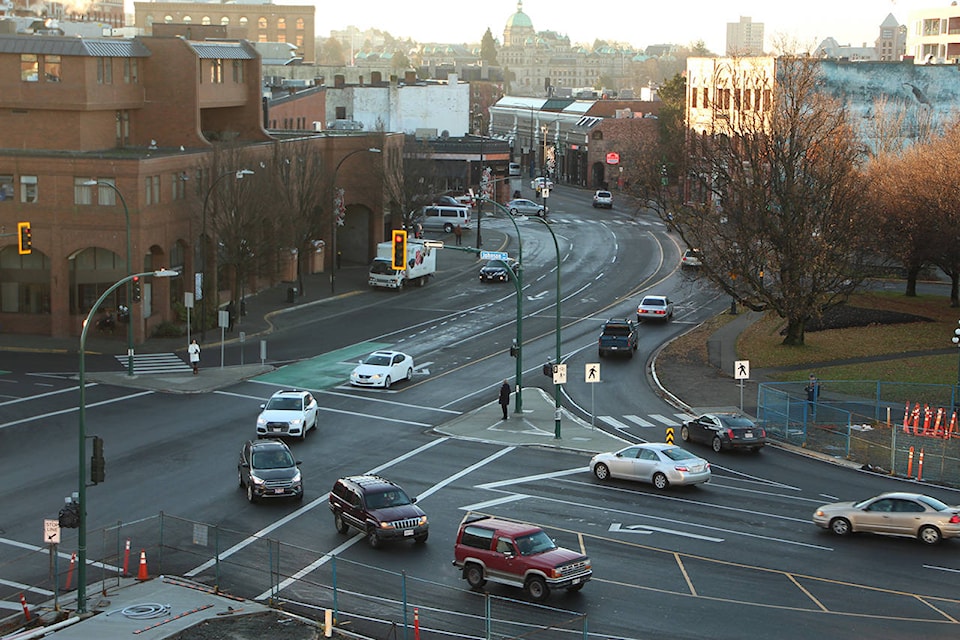UPDATE: The public hearing for the zoning bylaw, scheduled for Thursday Dec. 14, was cancelled so city staff can review new information, according to the City of Victoria’s website.
Passing a proposed omnibus zoning bylaw for downtown Victoria after a public hearing this week may run the risk of reducing community and council oversight in the development process.
City council, sitting as committee of the whole Thursday (Dec. 7), heard their request for clarification in response to a letter from the Downtown Residents Association (DRA) on Zoning Bylaw 2017, an omnibus bylaw that simplifies upwards of 80 different zone types into three general types downtown.
The proposed bylaw would change off-street parking requirements; creates definitions and regulations of brew pubs, distilleries, wineries and drinking establishments; and removes both light industrial and short-term rentals from acceptable land use.
In the letter, the association identified a number of issues that could arise if the bylaw is adopted, mainly that the chance for public notification and input, and council oversight, is significantly reduced. They were also concerned about potential impacts on the types of housing allowed downtown if parking requirements are reduced, which they said may encourage a higher number of micro suites and lock-off units.
Ian Sutherland, chair of the land-use committee for the DRA, said streamlining the development process could have unintentional consequences.
In the past, he noted, the City would create specific zones for each lot with allowable density and land use, as each development application came up.
This “checkerboard of weird zones,” he said, acts as a tripwire that triggers the rezoning process because the land use and density allowances are site-specific.
The rezoning process then begins, which includes notices to neighbours, consultation with community land-use committees and debate by city council, followed by a public hearing.
“You’re going from a very open, consultative system, to a very closed system,” he said. “Whenever you try something like this, that big and complicated, there’s always unforeseen consequences.
“Council is giving up their power … to decline applications. Once it’s pre-zoned and the applicant comes in with something that essentially complies with the use and density, there’s not much they can do.”
RELATED: New Victoria zoning bylaw would cut red tape for developers, downtown property owners
Currently, rezoning requests are triggered by changes in either land use or density. The new zoning bylaw, according to Sutherland, would homogenize the zones by giving many of the lots the same land use. Rezoning would then only be triggered by changes to density or when variances are requested.
Coun. Charlayne Thornton Joe said at the meeting she heard developers were eager for this bylaw to be approved, “and that concerns me.”
“If applicants are eagerly awaiting us to approve something, what am I missing?” she said. “Why can’t it be slowed down? Why can’t there be further discussions?”
Jonathan Tinney, the City’s director of planning, responded that the DRA seems to expect a substantial change in the number of applications referred to their land-use committees. That is not the case, he said, adding the changes were primarily administrative, including the changing definitions and formats of zones.
“The current height limits, the current density limits on the existing zones in the downtown core will remain,” he said. “An application that needs additional density today, would still need additional density tomorrow.”
“This is meant to be administrative, meant to make the bylaw simpler, to make something that is more cohesive.”
Coun. Pamela Madoff said labelling the bylaw as “administrative cleanup” or “housekeeping” could be misleading. Using the development permit process – which council has significantly less control over – could be expanded, and rezoning reduced.
“Being told how limited our authority is, the fact that it doesn’t go to a community land use committee, the fact that we don’t advertise it in the newspaper, yet we say we are inviting public comment. I don’t think that lines up with what I think our principles are as a council, in terms of our public consultation desire and our transparency,” she said.
“It’s too important, in a time where we’re seeing surface parking lots in Old Town being developed in a way that we have never seen before, that we have the appropriate oversight over them, and instead, we’re moving backwards.”
According to the DRA letter, approving the bylaw would make it easier to combine lots and create massive buildings without triggering a rezoning. City staff will be presenting an amendment immediately following Zoning Bylaw 2017 approval to prevent this for the parcels of land identified by the DRA. Future developments would still need to obtain a permit and fit with design guidelines.
There could be benefits to consolidating some downtown lots, said Tinney, provided they follow the City’s design guidelines for Old Town. Those benefits could include underground parking with only one entrance, only having one garbage enclosure and one residential lobby.
Councillors who spoke appeared conflicted on the bylaw, but forwarded it to public hearing this Thursday night (Dec. 14, 7 p.m.). For more information search for “zoning bylaw 2017” at victoria.ca.
